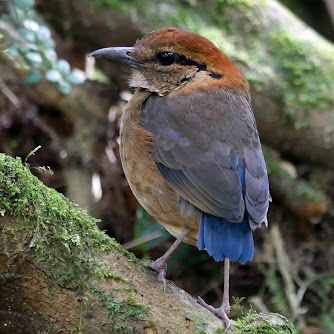Notable Splits in 2023
Chirruping Nightjar (Caprimulgus griseatus) and Savanna Nightjar (Caprimulgus affinis) are split from Savanna Nightjar (Caprimulgus affinis). Vocal differences have recently been highlighted for griseatus, the monticolus Group, and the affinis Group, but the differences between griseatus and the taxa under Savanna Nightjar are more striking. Vocal differences in nightjars are extremely important for defining species limits and in this case they warranted a split. These taxa don’t overlap in range, so identification should not be a major issue.
Savanna Nightjar (Northern) Caprimulgus affinis [monticolus Group]. Widespread in South and Southeast Asia.
Savanna Nightjar (Sunda) Caprimulgus affinis [affinis Group]. Found in Indonesia: Greater and Lesser Sundas, Sulawesi.
Chirruping Nightjar Caprimulgus griseatus is found in Philippines.
Lesser Sand-Plover (Charadrius mongolus) is split into Siberian Sand-Plover (Anarhynchus mongolus) and Tibetan Sand-Plover (Anarhynchus atrifrons) [note also the change in genus from Charadrius to Anarhynchus that is taking place this year.]
Siberian Sand-Plover Anarhynchus mongolus. Found in E Siberia and Russian Far East to Kamchatka to Chukotsk Peninsula; winters Taiwan to Australia (but yet unrecorded in Thailand).
Tibetan Sand-Plover Anarhynchus atrifrons. Found in Pamirs to w China (w Xinjiang), Himalayas and Tibet to s Mongolia; winters to Africa, India, Myanmar, Thailand, Malaysia, Sumatra to Greater Sundas. Most of the Pamirs lie within Tajikistan, but the fringes penetrate Afghanistan, China, and Kyrgyzstan. The core of the Pamirs is in the highlands of Tajikistan, with the highest mountains in the Gorno-Badakhshan autonomous oblast (province)
Cattle Egret is split into eastern and western populations (the western birds are the ones that colonized the Americas), so birders should get used to Western Cattle Egret (Bubulcus ibis) and Eastern Cattle Egret (Bubulcus coromandus). In Peninsular Malaysia, this bird is now known as Eastern Cattle Egret.
Intermediate Egret (Ardea intermedia) is being split into three species: Yellow-billed Egret (Ardea brachyrhyncha) of Africa, Medium Egret (Ardea intermedia) distributed broadly in South, Southeast, and East Asia, and Plumed Egret (Ardea plumifera) of Australasia. In Peninsular Malaysia, this bird is now known as Medium Egret.
Black-eared Barbet Psilopogon duvaucelii is split from Blue-eared Barbet Psilopogon cyanotis. The two species are almost identical in voice but have striking differences in face pattern and a narrow contact zone. A third member of the complex, Yellow-eared Barbet Psilopogon australis (formerly Little Barbet), is restricted to Java and Bali and has been split for multiple years but illustrates how species limits turn over in this species. However, there is an overlap (and hybrid!) zone in southern Thailand and northern Malaysia.
Blue-eared Barbet Psilopogon cyanotis. Widespread in Southeast Asia south down Malay Peninsula to southern Thailand.
Black-eared Barbet Psilopogon duvaucelii. Found in southern Thai-Malay Peninsula (from southern Thailand southward), Sumatra (and adjacent islands), Bangka Island, and Borneo.
* extracted relevant information from eBird website
Notable Splits in 2023
Chirruping Nightjar (Caprimulgus griseatus) and Savanna Nightjar (Caprimulgus affinis) are split from Savanna Nightjar (Caprimulgus affinis). Vocal differences have recently been highlighted for griseatus, the monticolus Group, and the affinis Group, but the differences between griseatus and the taxa under Savanna Nightjar are more striking. Vocal differences in nightjars are extremely important for defining species limits and in this case they warranted a split. These taxa don’t overlap in range, so identification should not be a major issue.
Savanna Nightjar (Northern) Caprimulgus affinis [monticolus Group]. Widespread in South and Southeast Asia.
Savanna Nightjar (Sunda) Caprimulgus affinis [affinis Group]. Found in Indonesia: Greater and Lesser Sundas, Sulawesi.
Chirruping Nightjar Caprimulgus griseatus is found in Philippines.
Lesser Sand-Plover (Charadrius mongolus) is split into Siberian Sand-Plover (Anarhynchus mongolus) and Tibetan Sand-Plover (Anarhynchus atrifrons) [note also the change in genus from Charadrius to Anarhynchus that is taking place this year.]
Siberian Sand-Plover Anarhynchus mongolus. Found in E Siberia and Russian Far East to Kamchatka to Chukotsk Peninsula; winters Taiwan to Australia (but yet unrecorded in Thailand).
Tibetan Sand-Plover Anarhynchus atrifrons. Found in Pamirs to w China (w Xinjiang), Himalayas and Tibet to s Mongolia; winters to Africa, India, Myanmar, Thailand, Malaysia, Sumatra to Greater Sundas. Most of the Pamirs lie within Tajikistan, but the fringes penetrate Afghanistan, China, and Kyrgyzstan. The core of the Pamirs is in the highlands of Tajikistan, with the highest mountains in the Gorno-Badakhshan autonomous oblast (province)
Cattle Egret is split into eastern and western populations (the western birds are the ones that colonized the Americas), so birders should get used to Western Cattle Egret (Bubulcus ibis) and Eastern Cattle Egret (Bubulcus coromandus). In Peninsular Malaysia, this bird is now known as Eastern Cattle Egret.
Intermediate Egret (Ardea intermedia) is being split into three species: Yellow-billed Egret (Ardea brachyrhyncha) of Africa, Medium Egret (Ardea intermedia) distributed broadly in South, Southeast, and East Asia, and Plumed Egret (Ardea plumifera) of Australasia. In Peninsular Malaysia, this bird is now known as Medium Egret.
Black-eared Barbet Psilopogon duvaucelii is split from Blue-eared Barbet Psilopogon cyanotis. The two species are almost identical in voice but have striking differences in face pattern and a narrow contact zone. A third member of the complex, Yellow-eared Barbet Psilopogon australis (formerly Little Barbet), is restricted to Java and Bali and has been split for multiple years but illustrates how species limits turn over in this species. However, there is an overlap (and hybrid!) zone in southern Thailand and northern Malaysia.
Blue-eared Barbet Psilopogon cyanotis. Widespread in Southeast Asia south down Malay Peninsula to southern Thailand.
Black-eared Barbet Psilopogon duvaucelii. Found in southern Thai-Malay Peninsula (from southern Thailand southward), Sumatra (and adjacent islands), Bangka Island, and Borneo.
* extracted relevant information from eBird website













